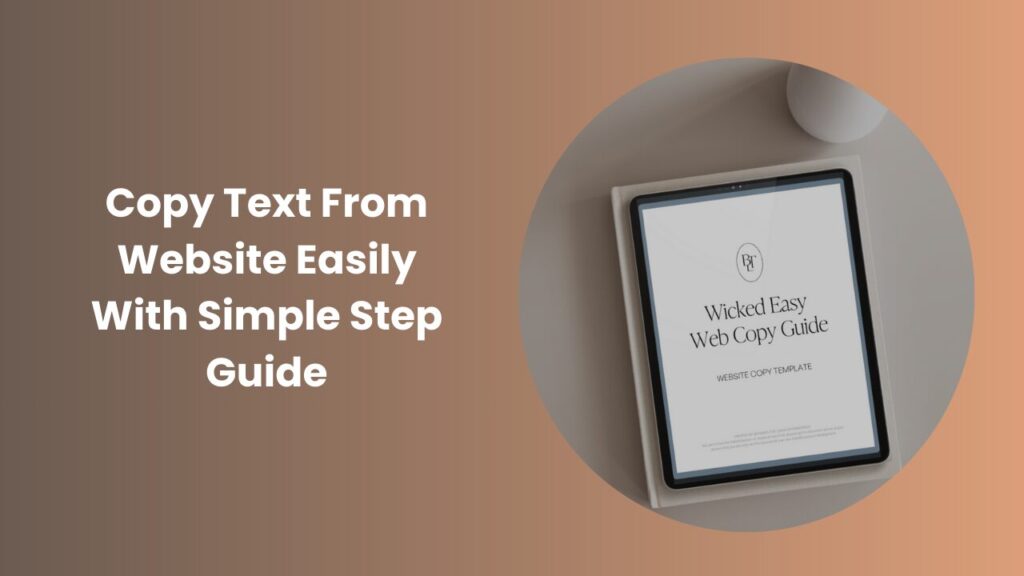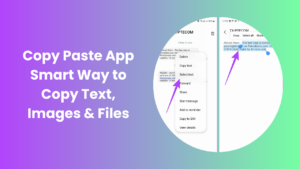In today’s digital age, where almost every aspect of our lives connects back to the internet, the ability to manage, preserve, and share information efficiently has become more important than ever. Every day, millions of people browse websites for knowledge, entertainment, research, and professional growth. Among the countless digital actions we perform, one of the simplest yet most essential is the ability to copy text from website pages. This function goes far beyond convenience; it serves as a bridge between information and usability, helping individuals save time, avoid errors, and keep important content within reach whenever needed.
For students, copying text means faster access to study material, accurate referencing of sources, and the ability to compile notes without the risk of misquoting. Professionals depend on it to prepare reports, design presentations, or collect data that must remain precise. Casual readers also benefit by storing favorite recipes, memorable quotes, travel guides, or helpful instructions that they might want to revisit later.
Why Copying Online Content Has Become So Important
Copying online content is not a new behavior, but its importance has grown tremendously with the expansion of digital education, remote work, and online publishing. People use copied text for research, self-study, professional growth, and personal organization. Unlike in the past, when writing by hand was the only option, today copying ensures both speed and accuracy.
For example, imagine a law student gathering case references from multiple sources. Instead of rewriting word-for-word, copying ensures the quotes remain precise. Similarly, a data analyst may copy statistical figures from reports to include in presentations without risking transcription errors. Even everyday users benefit by copying instructions, news snippets, or travel tips for later use. In short, the action of copying supports both productivity and learning across multiple fields.
Why Websites Restrict Copying in the First Place
Although users often see copying as harmless, website owners sometimes put restrictions in place. These protections serve as digital barriers to prevent misuse of valuable content. Some sites disable right-click options, others use scripts to block text highlighting, and premium platforms often place content behind subscription models.
The motivations vary. A publishing site may want to prevent its articles from being reposted without permission. An e-learning platform may restrict copying to encourage students to purchase complete access. A research journal might lock text to maintain its value as exclusive, paid content. While frustrating for users, these steps are designed to safeguard intellectual property, traffic, and revenue.
Legal and Ethical Dimensions of Copying
The issue of copying brings us to the important subjects of legality and ethics. From a legal perspective, copyright laws protect original work whether in print or online. Copying entire sections of an article and publishing them elsewhere without permission clearly violates copyright. However, copying for personal, educational, or research purposes often falls under fair use.
The ethical perspective goes beyond legal compliance. Even when the law permits copying, respecting the effort of authors is crucial. Crediting sources, paraphrasing instead of duplicating, and avoiding misuse are ways to act responsibly. By approaching copying with fairness, users preserve trust and maintain the internet as a reliable space for knowledge-sharing.
Everyday Methods of Copy Text From Website
For unrestricted websites, copying is easy. Highlight the text, right-click, and copy it’s done in seconds. But when websites apply protections, alternative methods become necessary.
Browser Tools and Shortcuts
Browsers like Chrome, Edge, and Firefox offer multiple functions that can help bypass restrictions. Disabling JavaScript temporarily allows users to highlight and copy content. Another option is “Inspect Element,” a tool that reveals the page’s underlying HTML code, where the text is usually visible. This method requires some technical confidence but is highly effective.
Reader Mode for Simplicity
Reader Mode is available in many browsers and strips away advertisements, images, and unnecessary formatting. What remains is clean, plain text that can be easily selected and copied. It also improves readability, making it especially useful for longer articles or research pieces.
Text Extraction Tools
Online tools can convert entire web pages into plain text files. These tools are useful when the goal is to preserve only the written material without the clutter of design elements. They are particularly popular among students and professionals who need to save long-form content quickly.
Screenshots and OCR
Sometimes, copying is impossible through normal means. In such cases, users can take screenshots and use Optical Character Recognition (OCR) software to turn the images into editable text. While this adds an extra step, it is reliable for both short and long passages, as well as locked PDF files.
Advanced Approaches for Restricted Websites
When basic tricks don’t work, advanced methods come into play.
Extensions and Add-ons
Certain browser extensions are designed to bypass copy restrictions. These add-ons can re-enable highlighting or right-click functionality. However, they must be used with caution—only trusted sources should be installed to avoid malware or privacy risks.
Saving as PDF or HTML
A useful technique is saving a webpage as a PDF or complete HTML file. Once saved offline, the file can be opened with text editors or PDF readers, making the content accessible without online restrictions.
Printing to PDF
The “Print to PDF” feature is another practical option. By saving the entire webpage as a document, users can later extract the text in a secure, organized format. This method is especially helpful for research papers or lengthy guides.
Challenges Users Face When Copying
Even when successful, copying text comes with certain challenges. Formatting is often lost, creating problems for students or professionals who rely on structured content. Code or advertisements sometimes get copied along with the text, requiring cleanup. Tables, charts, or specialized layouts can also break, leading to inaccuracies.
For example, a student trying to copy a research table may find the alignment destroyed in a text editor. Similarly, a professional copying statistical data might lose numerical formatting, creating confusion. These small but significant challenges highlight why reliable tools and careful editing are important after copying.
Responsible Use of Copied Content
Having access to content should not mean abusing it. Responsible copying means taking only what is necessary, respecting ownership, and acknowledging authors when sharing publicly. For professionals, citing sources builds credibility. For students, paraphrasing instead of duplicating strengthens learning and avoids plagiarism.
Ethical usage also helps maintain the internet’s balance. When creators see that their work is respected, they are encouraged to continue producing valuable content. If copying becomes excessive and abusive, however, it discourages creation and weakens the trustworthiness of online spaces.
Future of Copying and Accessibility
Looking ahead, both content restrictions and accessibility tools will evolve further. Publishers may adopt advanced digital rights management, watermarking, or subscription-based access. At the same time, artificial intelligence and new technologies will make copying for legitimate purposes easier.
AI-driven tools already summarize articles, highlight key points, and convert images into text. These tools may soon offer smarter ways to save online content while automatically providing citations. Educational platforms might introduce balanced models where partial access is free but deeper insights require membership. The challenge will be ensuring that the internet continues to provide open access to knowledge while still protecting the rights of creators.
Conclusion
The ability to copy text from website pages remains an essential part of modern digital life. Students, professionals, and everyday users all rely on it to save time, preserve accuracy, and enhance productivity. While restrictions exist to protect creators, users still have access to numerous tools and methods from browser features and reader modes to OCR and advanced saving techniques. The real key lies in using these methods responsibly, ensuring that information is accessed fairly and ethically. By respecting both convenience and copyright, we can continue to benefit from the vast knowledge available online while supporting the work of those who create it.
FAQs
Is it legal to copy information from the internet?
Copying for personal study, research, or reference often falls under fair use, but republishing large portions without permission can violate copyright laws. It’s always safer to check usage rights and give proper credit.
Why do some websites block text selection?
Websites often block text selection to protect their content from being copied and misused. This helps creators safeguard their intellectual property and maintain the value of their original work.
How can I save online information if copying is not allowed?
If copying isn’t possible, you can use browser reading modes, save the page as a PDF, or write down key details manually. Paraphrasing in your own words is another safe and ethical option.
What is the safest way to handle copied content?
The safest way is to copy only what you truly need and keep it for personal use. When sharing publicly, always credit the original source to respect copyright and support content creators.





